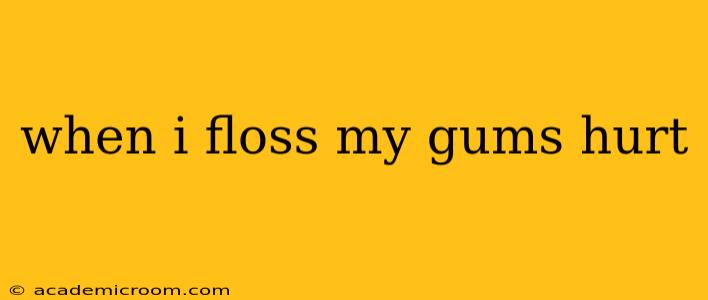Flossing is crucial for maintaining good oral hygiene, yet many people experience gum pain afterward. This isn't necessarily a sign that you're flossing incorrectly, although technique plays a role. Understanding the causes of this discomfort and learning proper flossing techniques can significantly alleviate the problem and help you maintain a healthy smile.
Why Do My Gums Hurt After Flossing?
Gum pain after flossing usually stems from one of several factors:
-
Gingivitis: This is the early stage of gum disease, characterized by inflamed and bleeding gums. If your gums are already inflamed, flossing can aggravate the condition, causing pain. The good news is that consistent flossing, along with brushing, can help reverse gingivitis.
-
Aggressive Flossing: Using too much force while flossing is a common culprit. Gently guiding the floss between teeth and along the gumline is key. Snapping the floss against your gums can cause trauma and inflammation.
-
Improper Flossing Technique: Incorrect technique can lead to gum irritation. Many people don't floss correctly, and this can damage the gums.
-
New to Flossing: If you're just starting to floss regularly, your gums might be more sensitive initially. This is because they aren't accustomed to the stimulation. Persistence is key—the sensitivity usually subsides as your gums become healthier.
-
Underlying Gum Disease (Periodontitis): In more severe cases, pain might indicate periodontitis, a more advanced form of gum disease. Periodontitis involves inflammation and damage to the tissues supporting your teeth, potentially leading to tooth loss if left untreated.
How Can I Make Flossing Less Painful?
Here's how to make flossing a less painful and more effective experience:
-
Use the Right Floss: Experiment with different types of floss. Waxed floss is often easier to maneuver between tight teeth than unwaxed floss. There are also floss picks available, which can be helpful for some individuals.
-
Gentle Technique: Don't snap or force the floss between your teeth. Gently curve the floss around each tooth in a "C" shape, hugging the gumline. Avoid sawing back and forth; instead, use a gentle up-and-down motion.
-
Start Slowly: If you're new to flossing or experiencing significant sensitivity, start by flossing only a few teeth at a time. Gradually increase the number of teeth you floss each day as your gums become less sensitive.
-
See a Dentist: If the pain persists despite employing proper technique, schedule an appointment with your dentist or periodontist. They can assess your oral health, diagnose any underlying gum disease, and recommend appropriate treatment.
What If My Gums Bleed When I Floss?
Bleeding gums are often a sign of gingivitis. While it might be alarming, bleeding doesn't necessarily mean you're harming your gums. It simply indicates that your gums are inflamed and irritated. Consistent gentle flossing, coupled with good brushing habits, can often improve the situation. However, if bleeding persists or is heavy, it's essential to see a dentist for a professional evaluation.
Should I Stop Flossing If My Gums Hurt?
No, you shouldn't stop flossing altogether. Consistent flossing is vital for preventing gum disease and maintaining oral health. However, if flossing is causing significant pain, focus on gentler techniques and gradually increase the amount of flossing you do. Consulting your dentist is crucial if the pain persists or worsens.
How Often Should I Floss?
The American Dental Association (ADA) recommends flossing at least once a day, ideally before brushing.
By understanding the potential causes of gum pain during flossing and adopting a gentler approach, you can maintain optimal oral health without experiencing unnecessary discomfort. Remember that consistent, gentle flossing is a cornerstone of preventing gum disease and keeping your smile healthy.
